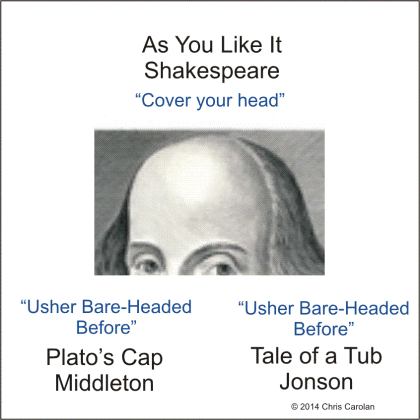Cover Your Head!
Back in September, Rambler blogged about Middleton’s mock-almanac, Plato’s Cap. The passage in question’
“…heroic-valiant beef, that ancient and surly courtier that never appears without a mess of mustard, his gentleman-usher bareheaded before him.”
That phrase caught my interest then, the association of the nobleman and servant, the inclusion of “mustard” invoking “not without mustard” from Every Man Out of His Humour, as well as the ‘ancient’ label, with Vere of course from that most ancient noble lineage. The ‘bare-headed before him’ refers to the protocol of state functions observed to this day where only the ushers of the nobility have bare heads, and they always precede their masters.
In A Tale of A Tub, act V, Medlay is planning the masque. This masque is essentially a shadow-puppet show.
“Medlay. You Squire-ship’s mother passeth by (her usher,
Master Pol-Marten, bareheaded before her)
In her velvet gown.SQUIRE TUB. But how shall the spectators,
As it might be, I, or Hilts, know ’tis my mother?
Or that Pol-Marten, there, that walks before her.MEDLAY. Oh, we do nothing if we clear not that.”
Act V sc vii
Tub is concerned that the Pol-Martin Lady Tub relationship will not be clear. Later during the masque, Tub interrupts Medlay’s presentation to clarify once again the representation of the bare-headed usher preceding Lady Tub.
“MEDLAY…Whilst Lady Tub in her sad velvet Gown,
Missing her son, doth seek him up and down.SQUIRE TUB With her Pol-Marten bare before her.
MEDLAY Yes, I have expressed it here in figure…”
Act V sc x
Jonson goes to great lengths to repeat that same image, the bare-headed servent preceding the nobility exactly as depicted by Middleton in Plato’s Cap.
Now lets revisit William in As You Like It, who is seen as Shakspere by Oxfordians. Here’s Touchstone’s initial greeting to William.
“TOUCHSTONE Good even, gentle friend. Cover thy head, cover thy
head; nay prithee, be covered. How old are you friend?”
Act V sc i
Shakespeare drives the point home three times. William is a servant.
click to enlarge
William Shakspere of Stratford was a servant. The point is made time and time again. We can count on Jonson to amplify any point he wants to insure we understand. And as Jonson is the likely architect of the First Folio, we can see the Droeshout’ portrait’s head, bare of everything, hat and hair, and grotesquely enlarged. The Droeshout head calls attention to itself. “Look at me – I’m bare-headed!”
And most importantly, the placement of the Droeshot portrait in the First Folio. It is bare-headed before the noble works.
more anon.



0 comments
Kick things off by filling out the form below.
Leave a Comment